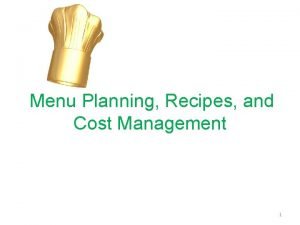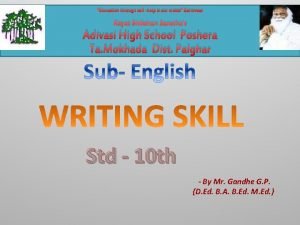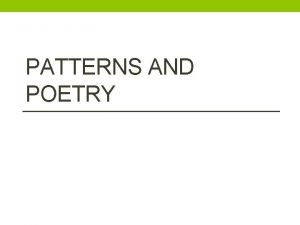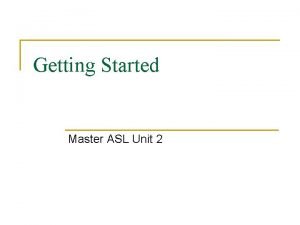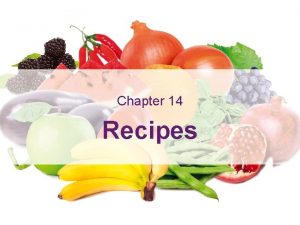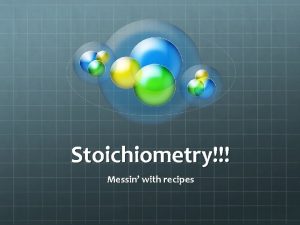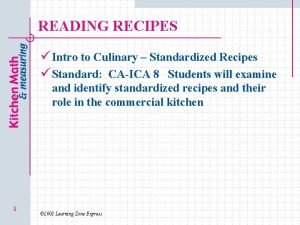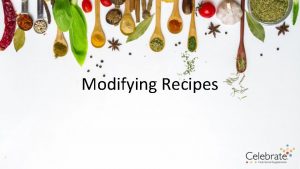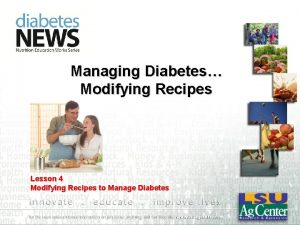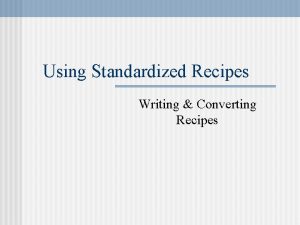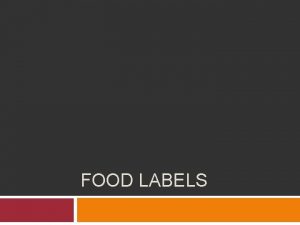Unit 6 Recipes and Food Cost Recipes help

















- Slides: 17

Unit 6: Recipes and Food Cost Recipes help organize, select ingredients, choose equipment, and help you track food cost American Culinary Federation: Culinary Fundamentals. © 2006, Pearson Education, Upper Saddle River, NJ 07458. All Rights Reserved.

American Culinary Federation: Culinary Fundamentals. © 2006, Pearson Education, Upper Saddle River, NJ 07458. All Rights Reserved.

What Is a Recipe? • Written record of ingredients and preparation • Improves efficiency • Increases profits • Gives each guest the same value each time American Culinary Federation: Culinary Fundamentals. © 2006, Pearson Education, Upper Saddle River, NJ 07458. All Rights Reserved.

Standardized Recipes • • Tailored to suit the needs of a restaurant Ensure consistent quality Monitor efficiency Allow the wait staff to answer guests’ questions American Culinary Federation: Culinary Fundamentals. © 2006, Pearson Education, Upper Saddle River, NJ 07458. All Rights Reserved.

Recipes Should Include • • • Main ingredient Cuisine, method Menu part Station Basic recipe Name title Yield information Number of portions Total weight and volume American Culinary Federation: Culinary Fundamentals. • • • Portion information Equipment information The method Service information Critical control points © 2006, Pearson Education, Upper Saddle River, NJ 07458. All Rights Reserved.

Reading Recipes Effectively • Read through before starting to cook • Pay attention to timing your steps • Check advance preparation of ingredients for the day before • Might include chilling or marinating or rehydration • Assemble and prepare all equipment • Allow for resting periods American Culinary Federation: Culinary Fundamentals. © 2006, Pearson Education, Upper Saddle River, NJ 07458. All Rights Reserved.

Changing the Yield • Establish the yield you need • Multiply number of portions by the size of the individual portion • Example: you need 40, 8 -oz portions of soup – Multiply 40 × 8 = 320 ounces – Convert to same common unit of measure 1 quart = 32 – 320 ounces divided by 32 = 10 quarts American Culinary Federation: Culinary Fundamentals. © 2006, Pearson Education, Upper Saddle River, NJ 07458. All Rights Reserved.

Mise en place • After reading, assemble all ingredients • Carefully weigh, count, or measure with the correct tools • Using scales or counting or measuring into a graded container is the proper method American Culinary Federation: Culinary Fundamentals. © 2006, Pearson Education, Upper Saddle River, NJ 07458. All Rights Reserved.

Converting to a Common Unit • • • 1 gallon is 4 quarts or 128 fluid ounces 1 quart is 2 pints or 32 ounces 1 pint is 2 cups or 16 ounces 1 cup is 16 tablespoons or 8 ounces 1 tablespoon is 3 teaspoons or ½ fluid ounce 1 pound is 16 ounces ¾ pound is 12 ounces ½ pound is 8 ounces ¼ pound is 4 ounces 1 ounce is ½ fluid ounce These are important units to commit to memory American Culinary Federation: Culinary Fundamentals. © 2006, Pearson Education, Upper Saddle River, NJ 07458. All Rights Reserved.

Recipe Conversion Factor (RCF) • Desired yield ÷ original yield = RCF • Multiply all the ingredients by the RCF to achieve the new amounts for ingredients • NOTE: The recipe conversion factor is greater than 1 if you are increasing and less then 1 if you are decreasing American Culinary Federation: Culinary Fundamentals. © 2006, Pearson Education, Upper Saddle River, NJ 07458. All Rights Reserved.

Converting Measurements • Convert between volume and weight • Convert between count and weight or volume • Round measurements into reasonable quantities • Convert measurements between U. S. and metric systems American Culinary Federation: Culinary Fundamentals. © 2006, Pearson Education, Upper Saddle River, NJ 07458. All Rights Reserved.

Convert Volume to Weight • Set a volume-measuring device on a scale • Set the tare weight • Fill the measuring device • Check and record the weight American Culinary Federation: Culinary Fundamentals. © 2006, Pearson Education, Upper Saddle River, NJ 07458. All Rights Reserved.

Convert from Count to Weight • Place a volume-measuring device onto a scale and set the tare weight • Place the ingredient into the measuring device and record the count and weight • Can be done with most items that are counted: shrimp, eggs, scallops American Culinary Federation: Culinary Fundamentals. © 2006, Pearson Education, Upper Saddle River, NJ 07458. All Rights Reserved.

Converting from Metric to U. S. and Vice Versa • Converting ounces and pounds to grams: – Multiply ounces by 28. 35 – Divide pounds by 2. 2 to determine kilograms • Grams to ounces: divide grams by 28. 35 = ounces • Fluid ounce to milliliters: multiply fluid ounces × 29. 58 = milliliters • Milliliters to ounces; divide milliliters by 29. 58 = fluid ounces American Culinary Federation: Culinary Fundamentals. © 2006, Pearson Education, Upper Saddle River, NJ 07458. All Rights Reserved.

Determining Food Cost • • You need accurate information Purchases Current cost from invoices and statements How is food prepared? Cost of each ingredient Amount of each ingredient Add up the cost of all ingredients = total recipe cost American Culinary Federation: Culinary Fundamentals. © 2006, Pearson Education, Upper Saddle River, NJ 07458. All Rights Reserved.

Calculating Yield Percentage • Food as you bought it = APQ • Food after trimming edible portion quantity = EPQ • Answer expressed as a percent • Formula = EPQ ÷ APQ = Yield Percentage • Multiplying APQ by the yield percentage will give you the weight after trimming • When you know the yield percentage, you can calculate back to the APQ using EPQ ÷ Yield Percentage = APQ American Culinary Federation: Culinary Fundamentals. © 2006, Pearson Education, Upper Saddle River, NJ 07458. All Rights Reserved.

Calculating as-Purchased Cost • You might need to break units down if you are not using a whole case • Tomatoes are $30. 00/case, you only need one can (10 cans per case) • $30. 00 ÷ 10 = $3. 00 per can • Can weighs 106 ounces; $3. 00 ÷ 106 equals. 03 cents per ounce • Amount called for in the ingredient list × the cost per unit = the total cost of the ingredient(s) American Culinary Federation: Culinary Fundamentals. © 2006, Pearson Education, Upper Saddle River, NJ 07458. All Rights Reserved.
 Menus recipes and cost management
Menus recipes and cost management Unit 2 food food food
Unit 2 food food food Las guayabas esperanza rising
Las guayabas esperanza rising Education through self help is our motto
Education through self help is our motto Help us help you
Help us help you I m being oppressed
I m being oppressed Help help chapter 1
Help help chapter 1 My mother makes me chicken
My mother makes me chicken Master asl unit 2 pdf answers
Master asl unit 2 pdf answers Food chain sequence
Food chain sequence Cost accumulation and cost assignment
Cost accumulation and cost assignment Cost accumulation and cost assignment
Cost accumulation and cost assignment Cost accumulation and cost assignment
Cost accumulation and cost assignment Cost accumulation and cost assignment
Cost accumulation and cost assignment Dennis geyer
Dennis geyer Standard cost
Standard cost Distinguish between average cost and marginal cost
Distinguish between average cost and marginal cost Cost control and cost reduction difference
Cost control and cost reduction difference
